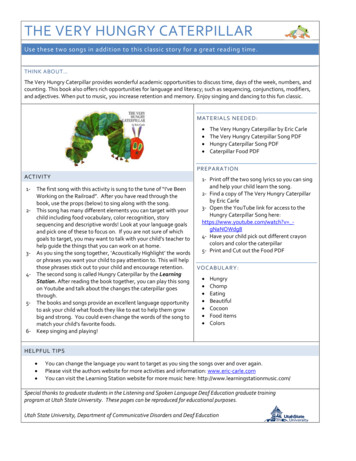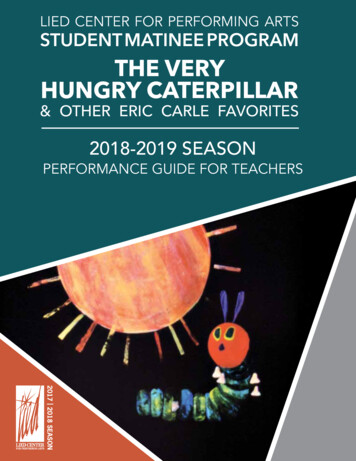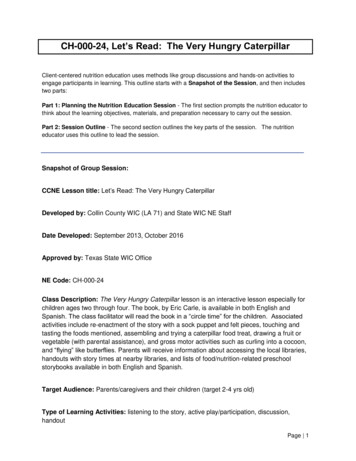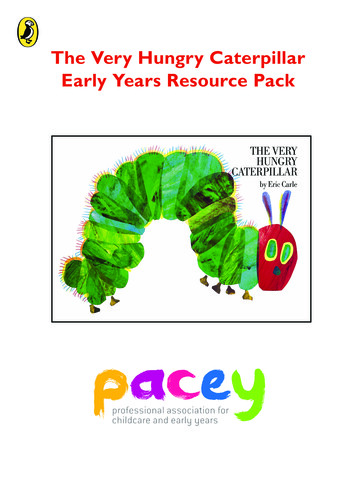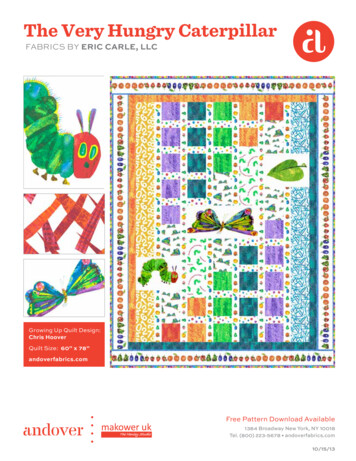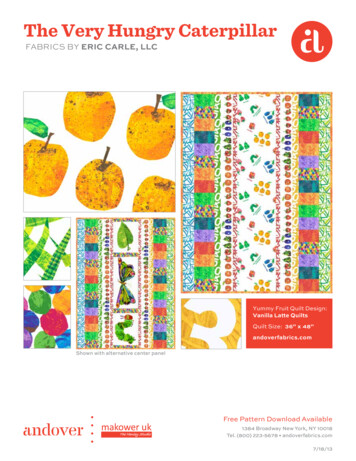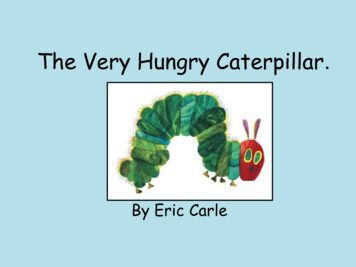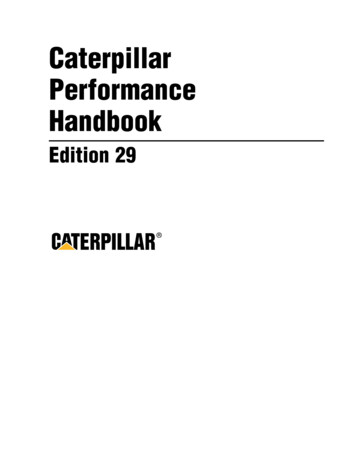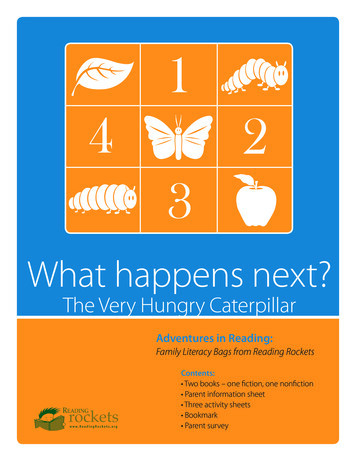
Transcription
1423What happens next?The Very Hungry CaterpillarAdventures in Reading:Family Literacy Bags from Reading RocketsContents: Two books – one fiction, one nonfiction Parent information sheet Three activity sheets Bookmark Parent survey
ADVENTURES IN READING : WHAT HAPPENS NEXT?vhcfor teachers and librariansThis Reading Rockets Activity Packet has been designed to support reading activities at home. Inhonor of the 40th Anniversary of Eric Carle’s picture book, The Very Hungry Caterpillar, we’vechosen some related books and created activities to encourage some hands-on fun and learning.The packet has been designed for you to assemble and send home with your pre-kindergartenand kindergarten students. The books and instructions should all fit in a two gallon zip top bag.Reading Rockets carefully chose books that are widely available and appealing to young readers. The titlesselected should be available in your school library. If the suggested titles are not available, or you preferanother title, please feel free to substitute books related to the theme.You’ll find our list of suggested titles included in bookmark format. The list includes both nonfiction titlesabout caterpillars and butterflies and fiction books that emphasize concepts such as counting, days ofthe week, or how things happen in sequence. When assembling your Very Hungry Caterpillar Activitypacket to send home, simply include a copy of The Very Hungry Caterpillar by Eric Carle and one of thenonfiction or concept books suggested.The parent information sheet includes an introductory note that you can personalize, instructions abouthow to use the packet, and tips for sharing fiction and nonfiction books with children.The activities were designed to encourage further exploration and learning at home: The Creativity activity is a hands-on craft project. The Imagination activity encourages imaginative play, writing, or drawing. The Get Real activity focuses on real-world experiences a child and parent can have together.The bookmark lists both the featured title and additional titles.Putting it all togetherPrint out copies of the parent information sheet, the activities, the survey, and a master for makingbookmarks from your computer. Cut the bookmark page into strips. You may wish to print the activitypages and bookmark on card stock for durability.Into a two gallon zip top bag, place: the two books–The Very Hungry Caterpillar and one nonfiction or concept book, the parent information sheet, the three activity pages, the bookmark, and a survey for parents to complete when they have finished using packet with their child.Send the packet home with your student. Encourage parents to keep the parent information sheet, theactivities, and bookmark, and return the books and survey to you by the date you specify.Let Reading Rockets know what you think of the family activity packets by e-mailing us through ourwebsite: www.readingrockets.org/sitecontact. Click on “Family Activity Packet feedback.”Adventures in Reading: Family Literacy Bags from Reading Rockets
ADVENTURES IN READING!WelcomeDearExploring new ideas and enjoying books with you sends a powerful message to your child: Reading andlearning are fun, and happen everywhere–not just at school. This Reading Rockets Activity Packet about TheVery Hungry Caterpillar was created to help you and your child enjoy reading and learning together.Start your learning adventure by reading some books with your child about this popular topic. Then explorethe topic with three activities. Enclosed you’ll find what you need: two books to share with your child, three related activities, a bookmark with a list of other books to extend the fun, if you wish, and a short survey to tell me if you enjoyed using the packet.The simple steps on the back explain how to use the packet.The bookmark, this parent information sheet, and the activities are yours to keep.When you’ve finished with the materials, please return the books and the completed survey to school in yourchild’s backpack. Please return the Reading Rockets Activity Packet by.I hope you’ll enjoy reading and learning together!Teacher signature here:Bring the fun of learning home with a Reading Rockets Activity Packet!Adventures in Reading: Family Literacy Bags from Reading Rockets
ADVENTURES IN READING!InstructionsHow to use your Reading Rockets Activity PacketGetting ready1. Before you read the books to your child, be sure to read them yourself. The firstbook is The Very Hungry Caterpillar by Eric Carle. This book is fiction — a “makebelieve” story — but it also teaches counting, the days of the week as well as aboutsequence and food. The other book is either nonfiction–or informational andtrue — about how caterpillars grow into butterflies, or a fiction book that featurescounting, the days of the week, or sequencing. Reading the books first will give youthe “inside scoop” to the twists and turns of the story, the interesting informationinside, and the parts of the books that will appeal most to your child.2. Next, read the three activities to see which of them you think your child willenjoy most, and which one you have the time and materials on-hand to do rightaway. Chances are, after you read one (or both) of the books with your child, he orshe may want to do an activity right away.Tips for reading fiction bookswith kids: Take your time and talk about thestory with your child. Ask your childquestions. Explore the pictures with your child. Read with expression. Change yourvoice or how fast you read to createexcitement. Ham it up! You don’t need to read every word.Keeping your child interested is thegoal.Start the fun3. When you know you’ll have at least enough time to read and talk about oneof the books, grab your child and a book, and dive right in. Start with The VeryHungry Caterpillar. Talk about the cover of the book with your child — can theyguess what it is about? Have they ever read a book by Eric Carle or a book aboutcaterpillars?Read the book to your child. Take time to ask and answer questions, explore thepictures, and wonder what will happen next. Read it again, if your child asks you to.Then, try the other book or one of the activities.4. If you read a nonfiction book, take a moment to explain to your child thedifference between the two types of books. The Very Hungry Caterpillar told amade-up, make-believe story, but a nonfiction book is about real butterflies andcaterpillars. The information in nonfiction books can answer lots of questions.Tips for reading nonfictionbooks with kids: Wonder out loud. As you are reading,or afterward, talk about facts you findinteresting or questions you have. Show your child how to use the tableof contents, section headings, index,glossary or word list to find the answerto a specific question. Don’t be afraid to jump around,reading pages that especially interestyour child. You don’t have to read anonfiction book straight through.5. Feel free to pick and choose from the activities, or change them to suit yourchild’s interests. Read the books again over the next few days and try different activities. Most important: have fun!When you’re done.6. Keep the bookmark, the activities, and this page. Complete the survey and return it with the books to your child’sschool. Visit a library and look for some of the other books on the bookmark.Make the most of the excitement the books create, and try some hands-on learning or make-believe fun. Exploringnew ideas along side you lets your child see you learning — and reading — too, and gives your child personalexperiences to support his or her growing knowledge.Adventures in Reading: Family Literacy Bags from Reading Rockets
CREATIVE ACTIVITY : WHAT HAPPENS NEXT?make a collage picturevhcEric Carle made his Very Hungry Caterpillar using collage. He makes the pictures for his books using specialpaper he creates by painting colors on tissue paper. After the paper dries, he cuts the paper into shapesand glues them together to make a picture. You can see how he does this at his website:www.eric-carle.com/slideshow collage.htmlCreate your own butterfly out of cut paper collage using the outline ofyour child’s hands.Supplies paintpaperpencilscissorsgluepipe cleanermarkers or crayonsInstructions1. With paint, make 3 sets of your child’s hand prints, or simply trace around your child’s hand on severalpieces of colored paper.2. Cut around the outline of your child’s hand to produce 6 separate hand prints; these are the butterflywings.3. Now draw the outline of a butterfly’s body on a dark piece of paper (a long oval with a small circle onthe top).4. Cut out the butterfly body and glue the body down on a plain sheet of paper.5. Glue 3 hand prints fanning out from each side of the butterfly with the fingers facing out.6. Bend the pipe cleaner in half to create the antenna and glue it down, or simply draw the antenna witha marker or crayon.7. Add eyes and decorate the wings with the markers or crayons.Explore other cut paper collage illustrations in the nonfiction book I’m a Caterpillar by Jean Marzollo. Italso tells the story of a caterpillar turning into a butterfly.Variation: Create a cut paper collage of your favorite foods using pictures of food cut out from magazines.Or, draw and color pictures of your favorite foods to be cut out. Glue the pieces down on a plain sheet ofpaper, filling the page with a colorful display of your child’s favorite foods.Read Feast for 10 by Cathryn Falwell or Growing Vegetable Soup by Lois Ehlert. They are also booksillustrated with cut paper collage and both are filled with different foods.Talk with your child about the different foods in his/her collage. Which foods are vegetables? Which arefruit? Discuss foods that are healthy that make us bigger and stronger.Adventures in Reading: Family Literacy Bags from Reading Rockets
GET REAL ACTIVITY : WHAT HAPPENS NEXT?growing, changing and learning!vhcEvery day your child grows and changes a little bit — just like the VeryHungry Caterpillar. And every day he learns something new too! Explorenumbers, days of the week, caterpillars, and the idea of beginning-middleand-end in the real world, and bring the Very Hungry Caterpillar to life.Make every day countPractice counting and naming the days of the week with your child. Count items you see every day — likepieces of toast, shoes on your feet, or wheels on the car. Try reading Ten Black Dots by Donald Crews and thenlet your child count and arrange ten checkers, pennies, or buttons to make pictures like Crews does. ReadFeast for Ten by Cathryn Falwell and count while you cook! Read Cookie’s Week and talk about your family’sschedule. “On Mondays we visit Grandma. On Tuesdays, we go to the library.”One thing leads to anotherExplore the idea of beginning, middle, and end — or sequence — with your child. Stories follow a sequence,so does the life cycle of a butterfly, and even doing laundry. Make your own butterfly life cycle. Have your child glue a dry grain of rice (egg), a piece of dry spiralpasta (caterpillar), a dry pasta shell (chrysalis), and a dry piece of bowtie pasta (butterfly) to a piece ofpaper and add arrows to show the sequence. Encourage them to draw leaves, twigs and flowers fortheir growing butterfly to explore. Look for examples of beginning, middle, and end throughout the day with your child (breakfast, lunch,and dinner, getting dressed, sunrise and sunset, doing laundry), and talk about how the sequencerepeats or changes. Talk about the beginning, middle, and end when you read a story with your child. Try GrowingVegetable Soup by Lois Ehlert, The Snowy Day by Ezra Jack Keats, Inch by Inch by Leo Lionni., orWaiting for Wings by Lois Ehlert.Grow a butterfly garden!Butterflies are attracted to certain plants and flowers. Put some in your own garden and watch the butterfliesand caterpillars come to you! rch your neighborhood or the internet for butterflies and caterpillars.National ls/CreatureFeature/Monarch-butterfliesThe National Wildlife Federation’s Ranger Rickhttp://www.nwf.org/kidZone/kzPage.cfm?siteID 3&departmentId 107&articleId 185click on llar.co.uk/Adventures in Reading: Family Literacy Bags from Reading Rockets
IMAGINATION ACTIVITY : WHAT HAPPENS NEXT?vhcbe a caterpillar or a butterflyExplore more with The Very Hungry Caterpillar by pretendingYou write the story:What would you eat if you were The Very Hungry Caterpillar? Create your own storybook titled “The VeryHungry CHILD’S NAME”. Create one page for each day of the week. Write the day of the week on eachpage. Have your child make up his/her own story by telling what foods he/she would eat each day of theweek. For example, “On Monday I ate one apple, on Tuesday I ate two quesadillas.” Have your child drawpictures of the food on each page to illustrate. Encourage your child to retell the story using the picturesas a guide.Act it out:Have your child act out the different life stages of the butterfly. Curl up in a ball like an egg, inch across thefloor and munch like a caterpillar, wrap yourself up in a towel like a caterpillar spinning a cocoon, flap yourwings and flutter around like a butterfly.Ask your child if he/she would prefer to be a caterpillar or a butterfly and why.When I grow up:The Very Hungry Caterpillar grows up to be a beautiful butterfly. What will you grow up to be one day?Maybe a scientist, a nurse, or even the President! Have your child draw a picture of him/herself whenhe/she grows up.Could that really happen?The Very Hungry Caterpillar is fiction — or make believe. Talk about the parts of the story that are real (i.e.caterpillars and butterflies do exist) and the parts that are make believe (i.e. caterpillars don’t really eat icecream cones!). Try reading Inch by Inch by Leo Lionni. Encourage your child to identify what parts of thestory are real and what parts are make believe.Adventures in Reading: Family Literacy Bags from Reading Rockets
ADVENTURES IN READING!Parent SurveyMy child and I read books and did activities together about:animalsthe environmentfolktalesfoodmusictimeTell us about your experience with the activities:easy and fun to dothe directions were difficult to understandmy child enjoyed the activitiesDid talking about what you were reading, and the activities help your child to learn? (on a scale of 1 to 5)1 2 3 4 5(did not learn much)(learned a lot)Would you like to try another “read and learn together” activity with your child? yes noWhat kinds of things is your child interested in?Adventures in Reading: Family Literacy Bags from Reading Rockets
Featured titlesFictionThe Very Hungry Caterpillar by EricCarleNonfictionBorn to be a Butterfly by Karen WallaceFrom Caterpillar to Butterfly byDeborah Heiligman, illustrated byBari Weissman, a Let’s-Read-AndFind-Out Science bookI’m a Caterpillar by Jean Marzollo,Illustrated by Judith MoffattSee How They Grow: Butterfly byMary LingMonarch Butterfly by Gail GibbonsConcept and Sequencing titlesCookie’s Week by Cindy Ward, illustratedby Tomie DePaolaFeast for 10 by Cathryn FalwellGrowing Vegetable Soup by Lois EhlertInch by Inch by Leo LionniThe Snowy Day by Ezra Jack KeatsTen Black Dots by Donald CrewsWaiting for Wings by Lois EhlertFeatured titlesFictionThe Very Hungry Caterpillar by EricCarleNonfictionBorn to be a Butterfly by Karen WallaceFrom Caterpillar to Butterfly byDeborah Heiligman, illustrated byBari Weissman, a Let’s-Read-AndFind-Out Science bookI’m a Caterpillar by Jean Marzollo,Illustrated by Judith MoffattSee How They Grow: Butterfly byMary LingMonarch Butterfly by Gail GibbonsConcept and Sequencing titlesCookie’s Week by Cindy Ward, illustratedby Tomie DePaolaFeast for 10 by Cathryn FalwellGrowing Vegetable Soup by Lois EhlertInch by Inch by Leo LionniThe Snowy Day by Ezra Jack KeatsTen Black Dots by Donald CrewsWaiting for Wings by Lois EhlertAdventures in Reading:Family Literacy Bags fromReading RocketsAdventures in Reading:Family Literacy Bags fromReading RocketsvhcvhcThe Very Hungry CaterpillarWhat happens next?The Very Hungry CaterpillarWhat happens next?Adventures in Reading:Family Literacy Bags fromReading RocketsWaiting for Wings by Lois EhlertTen Black Dots by Donald CrewsThe Snowy Day by Ezra Jack KeatsInch by Inch by Leo LionniGrowing Vegetable Soup by Lois EhlertFeast for 10 by Cathryn FalwellConcept and Sequencing titlesCookie’s Week by Cindy Ward, illustratedby Tomie DePaolaMonarch Butterfly by Gail GibbonsSee How They Grow: Butterfly byMary LingI’m a Caterpillar by Jean Marzollo,Illustrated by Judith MoffattFrom Caterpillar to Butterfly byDeborah Heiligman, illustrated byBari Weissman, a Let’s-Read-AndFind-Out Science bookNonfictionBorn to be a Butterfly by Karen WallaceFictionThe Very Hungry Caterpillar by EricCarleFeatured titlesvhcThe Very Hungry CaterpillarWhat happens next?Adventures in Reading:Family Literacy Bags fromReading RocketsWaiting for Wings by Lois EhlertTen Black Dots by Donald CrewsThe Snowy Day by Ezra Jack KeatsInch by Inch by Leo LionniGrowing Vegetable Soup by Lois EhlertFeast for 10 by Cathryn FalwellConcept and Sequencing titlesCookie’s Week by Cindy Ward, illustratedby Tomie DePaolaMonarch Butterfly by Gail GibbonsSee How They Grow: Butterfly byMary LingI’m a Caterpillar by Jean Marzollo,Illustrated by Judith MoffattFrom Caterpillar to Butterfly byDeborah Heiligman, illustrated byBari Weissman, a Let’s-Read-AndFind-Out Science bookNonfictionBorn to be a Butterfly by Karen WallaceFictionThe Very Hungry Caterpillar by EricCarleFeatured titlesvhcThe Very Hungry CaterpillarWhat happens next?
The Very Hungry Caterpillar told a made-up, make-believe story, but a nonfiction book is about real butterflies and caterpillars. The information in nonfiction books can answer lots of questions. 5. Feel free to pick and choose from the activities, or change them to suit your child's interests.
